-
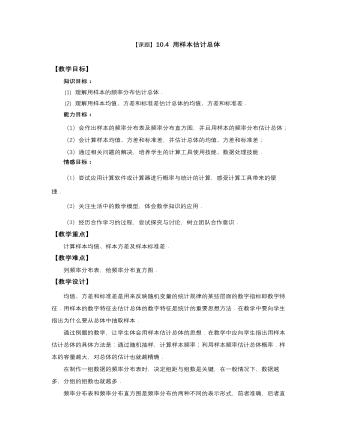
高教版中职数学基础模块下册:10.4《用样本估计总体》教学设计
教 学 过 程教师 行为学生 行为教学 意图时间 *揭示课题 10.4 用样本估计总体 *创设情境 兴趣导入 【知识回顾】 初中我们曾经学习过频数分布图和频数分布表,利用它们可以清楚地看到数据分布在各个组内的个数. 【知识巩固】 例1 某工厂从去年全年生产某种零件的日产记录(件)中随机抽取30份,得到以下数据: 346 345 347 357 349 352 341 345 358 350 354 344 346 342 345 358 348 345 346 357 350 345 352 349 346 356 351 355 352 348 列出频率分布表. 解 分析样本的数据.其最大值是358,最小值是341,它们的差是358-341=17.取组距为3,确定分点,将数据分为6组. 列出频数分布表 【小提示】 设定分点数值时需要考虑分点值不要与样本数据重合. 分 组频 数 累 计频 数340.5~343.5┬2343.5~346.5正 正10346.5~349.5正5349.5~352.5正  ̄6352.5~355.5┬2355.5~358.5正5合 计3030 介绍 质疑 引领 分析 讲解 说明 了解 观察 思考 解答 启发 学生思考 0 10*动脑思考 探索新知 【新知识】 各组内数据的个数,叫做该组的频数.每组的频数与全体数据的个数之比叫做该组的频率. 计算上面频数分布表中各组的频率,得到频率分布表如表10-8所示. 表10-8 分 组频 数频 率340.5~343.520.067343.5~346.5100.333346.5~349.550.167349.5~352.560.2352.5~355.520.067355.5~358.550.166合 计301.000 根据频率分布表,可以画出频率分布直方图(如图10-4). 图10-4 频率分布直方图的横轴表示数据分组情况,以组距为单位;纵轴表示频率与组距之比.因此,某一组距的频率数值上等于对应矩形的面积. 【想一想】 各小矩形的面积之和应该等于1.为什么呢? 【新知识】 图10-4显示,日产量为344~346件的天数最多,其频率等于该矩形的面积,即 . 根据样本的数据,可以推测,去年的生产这种零件情况:去年约有的天数日产量为344~346件. 频率分布直方图可以直观地反映样本数据的分布情况.由此可以推断和估计总体中某事件发生的概率.样本选择得恰当,这种估计是比较可信的. 如上所述,用样本的频率分布估计总体的步骤为: (1) 选择恰当的抽样方法得到样本数据; (2) 计算数据最大值和最小值、确定组距和组数,确定分点并列出频率分布表; (3) 绘制频率分布直方图; (4) 观察频率分布表与频率分布直方图,根据样本的频率分布,估计总体中某事件发生的概率. 【软件链接】 利用与教材配套的软件(也可以使用其他软件),可以方便的绘制样本数据的频率分布直方图,如图10-5所示. 图10?5 讲解 说明 引领 分析 仔细 分析 关键 语句 观察 理解 记忆 带领 学生 分析 25
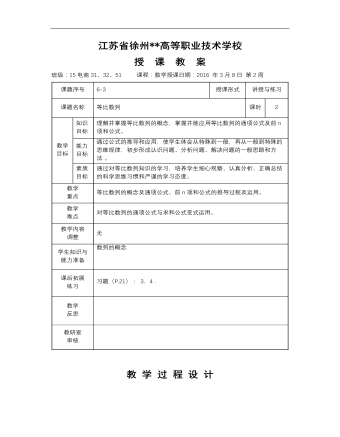
高教版中职数学基础模块下册:6.3《等比数列》教学设计
课题序号6-3授课形式讲授与练习课题名称等比数列课时2教学 目标知识 目标理解并掌握等比数列的概念,掌握并能应用等比数列的通项公式及前n项和公式。能力 目标通过公式的推导和应用,使学生体会从特殊到一般,再从一般到特殊的思维规律,初步形成认识问题、分析问题、解决问题的一般思路和方法 。素质 目标通过对等比数列知识的学习,培养学生细心观察、认真分析、正确总结的科学思维习惯和严谨的学习态度。教学 重点等比数列的概念及通项公式、前n项和公式的推导过程及运用。教学 难点对等比数列的通项公式与求和公式变式运用。教学内容 调整无学生知识与 能力准备数列的概念课后拓展 练习 习题(P.21): 3,4.教学 反思 教研室 审核
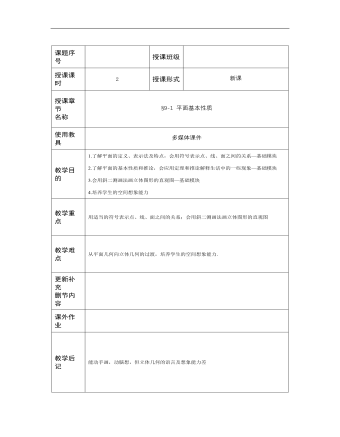
高教版中职数学基础模块下册:9.1《平面的基本性质》教学设计
课题序号 授课班级 授课课时2授课形式新课授课章节 名称§9-1 平面基本性质使用教具多媒体课件教学目的1.了解平面的定义、表示法及特点,会用符号表示点、线、面之间的关系—基础模块 2.了解平面的基本性质和推论,会应用定理和推论解释生活中的一些现象—基础模块 3.会用斜二测画法画立体图形的直观图—基础模块 4.培养学生的空间想象能力教学重点用适当的符号表示点、线、面之间的关系;会用斜二测画法画立体图形的直观图教学难点从平面几何向立体几何的过渡,培养学生的空间想象能力.更新补充 删节内容 课外作业 教学后记能动手画,动脑想,但立体几何的语言及想象能力差
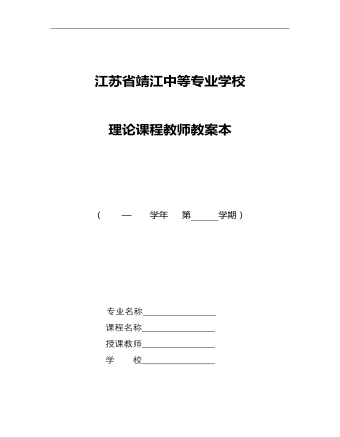
高教版中职数学基础模块下册:9.5《柱、锥、球及其简单组合体》教学设计
课题序号 授课班级 授课课时2授课形式 教学方法 授课章节 名称9.5柱、锥、球及其组合体使用教具 教学目的1、使学生认识柱、锥、球及其组合体的结构特征,并能运用这些特征描述生活中简单物体的结构。 2、让学生了解柱、锥、球的侧面积和体积的计算公式。 3、培养学生观察能力、计算能力。
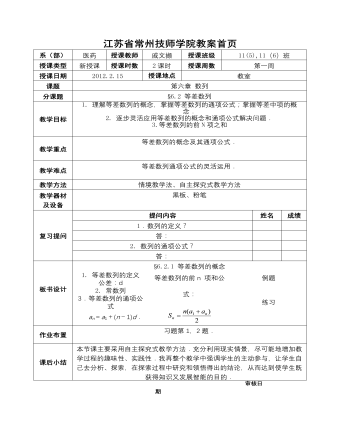
高教版中职数学基础模块下册:6.2《等差数列》教学设计
系(部)医药授课教师戚文撷授课班级11(5),11(6)班授课类型新授课授课时数2课时授课周数第一周授课日期2012.2.15授课地点 教室课题第六章数列分课题§6.2 等差数列教学目标1. 理解等差数列的概念,掌握等差数列的通项公式;掌握等差中项的概念. 2. 逐步灵活应用等差数列的概念和通项公式解决问题. 3.等差数列的前N项之和 . 4.培养学生分析、比较、归纳的逻辑思维能力. . 2. 3.教学重点等差数列的概念及其通项公式. 教学难点等差数列通项公式的灵活运用. 教学方法情境教学法、自主探究式教学方法教学器材及设备黑板、粉笔复习提问提问内容姓名成绩1.数列的定义? 答: 2. 数列的通项公式? 答: 板书设计 §6.2.1等差数列的概念 1. 1.等差数列的定义 公差:d 2.常数列 3.等差数列的通项公式 an=a1+(n-1)d. 等差数列的前n 项和公式: 例题 练习作业布置习题第1,2题.课后小结本节课主要采用自主探究式教学方法.充分利用现实情景,尽可能地增加教学过程的趣味性、实践性.我再整个教学中强调学生的主动参与,让学生自己去分析、探索,在探索过程中研究和领悟得出的结论,从而达到使学生既获得知识又发展智能的目的.
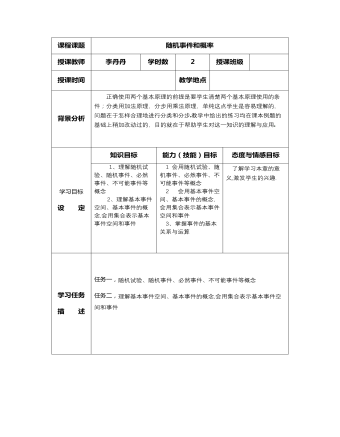
高教版中职数学基础模块下册:10.2《概率》教学设计
课程课题随机事件和概率授课教师李丹丹学时数2授课班级 授课时间 教学地点 背景分析正确使用两个基本原理的前提是要学生清楚两个基本原理使用的条件;分类用加法原理,分步用乘法原理,单纯这点学生是容易理解的,问题在于怎样合理地进行分类和分步教学中给出的练习均在课本例题的基础上稍加改动过的,目的就在于帮助学生对这一知识的理解与应用 学习目标 设 定知识目标能力(技能)目标态度与情感目标1、理解随机试验、随机事件、必然事件、不可能事件等概念 2、理解基本事件空间、基本事件的概念,会用集合表示基本事件空间和事件 1 会用随机试验、随机事件、必然事件、不可能事件等概念 2 会用基本事件空间、基本事件的概念,会用集合表示基本事件空间和事件 3、掌握事件的基本关系与运算 了解学习本章的意义,激发学生的兴趣. 学习任务 描 述 任务一,随机试验、随机事件、必然事件、不可能事件等概念 任务二,理解基本事件空间、基本事件的概念,会用集合表示基本事件空间和事件
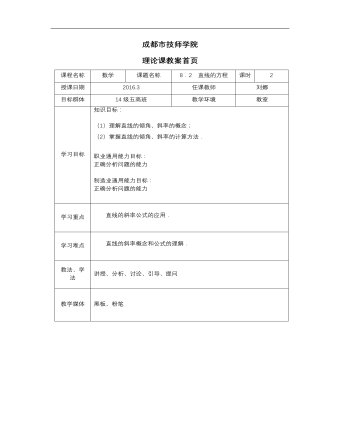
高教版中职数学基础模块下册:8.2《直线的方程》教学设计
课程名称数学课题名称8.2 直线的方程课时2授课日期2016.3任课教师刘娜目标群体14级五高班教学环境教室学习目标知识目标: (1)理解直线的倾角、斜率的概念; (2)掌握直线的倾角、斜率的计算方法. 职业通用能力目标: 正确分析问题的能力 制造业通用能力目标: 正确分析问题的能力学习重点直线的斜率公式的应用.学习难点直线的斜率概念和公式的理解.教法、学法讲授、分析、讨论、引导、提问教学媒体黑板、粉笔
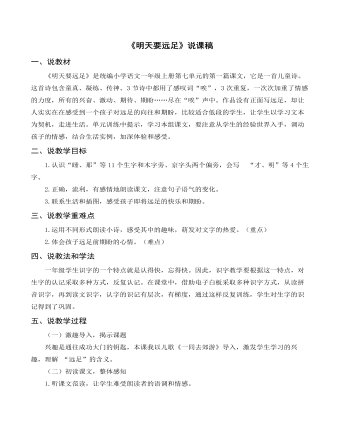
部编人教版一年级上册《明天要远足》说课稿
二、说教学目标1.认识“睡、那”等11个生字和木字旁、京字头两个偏旁,会写 “才、明”等4个生字。2.正确,流利,有感情地朗读课文,注意句子语气的变化。3.联系生活和插图,感受孩子即将远足的快乐和期盼。三、说教学重难点1.运用不同形式朗读小诗,感受其中的趣味,萌发对文字的热爱。(重点)?2.体会孩子远足前期盼的心情。(难点)四、说教法和学法一年级学生识字的一个特点就是认得快,忘得快。因此,识字教学要根据这一特点,对生字的认记采取多种方式,反复认记。在课堂中,借助电子白板采取多种识字方式,从读拼音识字,再到读文识字,认字的识记有层次,有梯度,通过这样反复训练,学生对生字的识记得到了巩固。
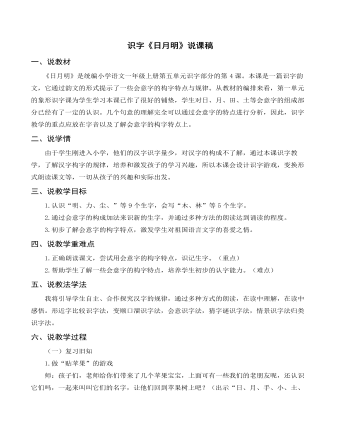
部编人教版一年级上册识字《日月明》说课稿
(三)变化形式,读熟课文,初识生字1.请大家打开书72页,借助拼音自读课文。2.指名读,纠正不正确的读音。3.这篇课文共有8横排,这次我们男女生PK,女生读前4排,男生读后4排,注意读准字音。4.生字宝宝来到了屏幕上,你能读吗?借助拼音自己读。哪个小老师来教一教,一人教两排。5.孩子们学得真认真,那我们给这些字宝宝排排队,睁大你的火眼金睛,你能看出他们的规律吗?正音归类:前鼻韵母(尘、林、森)、后鼻韵母(明、从、中)、平舌音(从、森)、翘舌音(尘、众)。6.你们真能干。不过,老师还要看大家是否真的掌握,一起来开火车。7.加大难度,去掉拼音读。看大屏幕!一组读一排。8.的确很专心。这次我们合作读,老师隐去了第三个字,首先男生读,第二遍女生读隐去一二个字的内容。
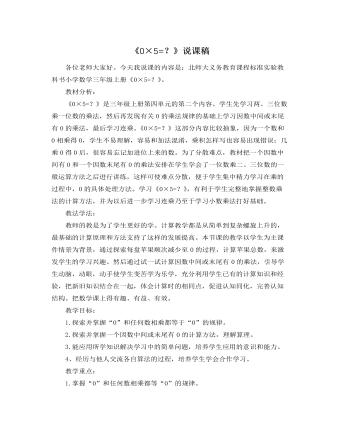
北师大版小学数学三年级上册《0×5=?》说课稿
各位老师大家好。今天我说课的内容是:北师大义务教育课程标准实验教科书小学数学三年级上册《0×5=?》。教材分析:《0×5=?》是三年级上册第四单元的第二个内容。学生先学习两、三位数乘一位数的乘法,然后再发现有关0的乘法规律的基础上学习因数中间或末尾有0的乘法,最后学习连乘。《0×5=?》这部分内容比较抽象,因为一个数和0相乘得0,学生不易理解,容易和加法混淆,乘积怎样写也容易出现错误;几乘0得0后,很容易忘记加进位上来的数。为了分散难点,教材把一个因数中间有0和一个因数末尾有0的乘法安排在学生学会了一位数乘二、三位数的一般运算方法之后进行讲练,这样可使难点分散,便于学生集中精力学习在乘的过程中,0的具体处理方法。学习《0×5=?》,有利于学生完整地掌握整数乘法的计算方法,并为以后进一步学习连乘乃至于学习小数乘法打好基础。
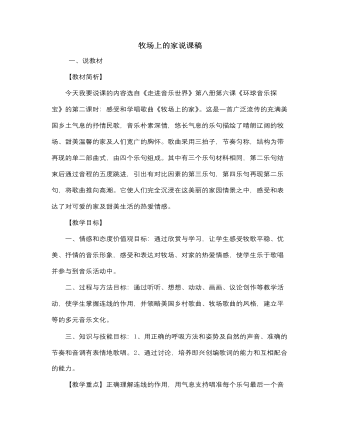
人音版小学音乐五年级上册牧场上的家说课稿
朴素深情悠长气息松散的节奏晴朗辽阔甜美温馨宽广的胸怀5、当学生唱两三次后,歌词就唱得较熟了,这时可以启发学生处理好歌曲中A乐句与B乐句的演唱力度,唱出mf与mp的力度对比。还可以启发他们用不同的演唱形式来表现音乐。6、教师范唱,最后全班用高位置的混声和圆润的音色来深情地演唱歌曲《牧场上的家》,尽情地表达对家乡的热爱。7、展示评价三、第三环节:拓展创编歌词(10分钟)听中编。同学们自编歌词,尽情歌唱自己的家。如:“猎德的家”、“我的家”、等。引导学生可根据我校综合实践课程的特色来创编歌词,歌唱猎德村改造前后的变化或心理感受。这时采用示范的方式展示和演唱老师创作的歌词,再让小组讨论并展示,还可让他们加上自制的打击乐器伴奏。最后是中肯的评价。
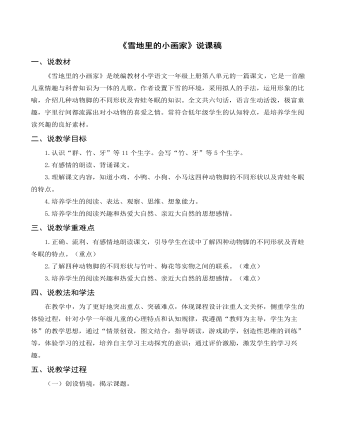
部编人教版一年级上册《雪地里的小画家》说课稿
一、说教材《雪地里的小画家》是统编教材小学语文一年级上册第八单元的一篇课文,它是一首融儿童情趣与科普知识为一体的儿歌。作者设置下雪的环境,采用拟人的手法,运用形象的比喻,介绍几种动物脚的不同形状及青蛙冬眠的知识。全文共六句话,语言生动活泼,极富童趣,字里行间都流露出对小动物的喜爱之情。常符合低年级学生的认知特点,是培养学生阅读兴趣的良好素材。二、说教学目标1.认识“群、竹、牙”等11个生字。会写“竹、牙”等5个生字。2.有感情的朗读、背诵课文。3.理解课文内容,知道小鸡、小鸭、小狗、小马这四种动物脚的不同形状以及青蛙冬眠的特点。
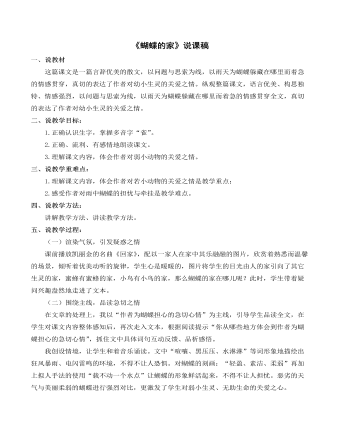
(新)部编人教版四年级上册《蝴蝶的家》说课稿
三、说教学重难点:1.理解课文内容,体会作者对若小动物的关爱之情是教学重点;2.感受作者对雨中蝴蝶的担忧与牵挂是教学难点。四、说教学方法: 讲解教学方法、讲读教学方法。五、说教学过程:(一)渲染气氛,引发疑惑之情课前播放凯丽金的名曲《回家》,配以一家人在家中其乐融融的图片,欣赏着熟悉而温馨的场景,倾听着优美动听的旋律,学生心是暖暖的,图片将学生的目光由人的家引向了其它生灵的家,蜜蜂有蜜蜂的家,小鸟有小鸟的家,那么蝴蝶的家在哪儿呢?此时,学生带着疑问兴趣盎然地走进了文本。
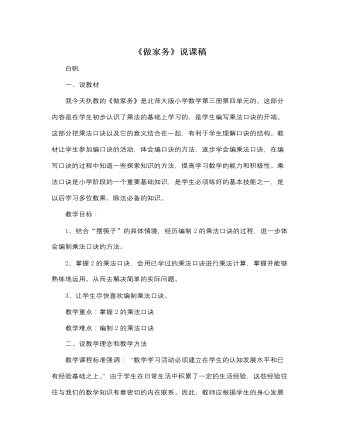
北师大版小学数学二年级上册《做家务》说课稿
一、说教材我今天执教的《做家务》是北师大版小学数学第三册第四单元的。这部分内容是在学生初步认识了乘法的基础上学习的,是学生编写乘法口诀的开端。这部分把乘法口诀以及它的意义结合在一起,有利于学生理解口诀的结构。教材让学生参加编口诀的活动,体会编口诀的方法,逐步学会编乘法口诀,在编写口诀的过程中知道一些探索知识的方法,提高学习数学的能力和积极性。乘法口诀是小学阶段的一个重要基础知识,是学生必须练好的基本技能之一,是以后学习多位数乘、除法必备的知识。教学目标:1、结合“摆筷子”的具体情境,经历编制2的乘法口诀的过程,进一步体会编制乘法口诀的方法。2、掌握2的乘法口诀,会用已学过的乘法口诀进行乘法计算,掌握并能够熟练地运用。从而去解决简单的实际问题。
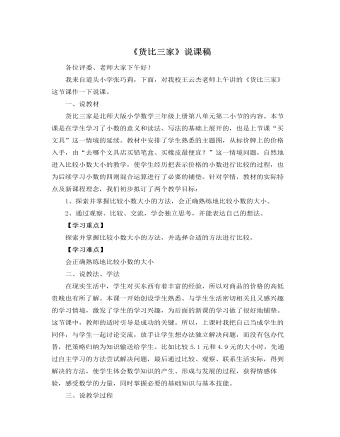
北师大版小学数学三年级上册《货比三家》说课稿
一、说教材货比三家是北师大版小学数学三年级上册第八单元第二小节的内容。本节课是在学生学习了小数的意义和读法、写法的基础上展开的,也是上节课“买文具”这一情境的延续。教材中安排了学生熟悉的主题图,从标价牌上的价格入手,由“去哪个文具店买铅笔盒、买橡皮最便宜?”这一情境问题,自然地进入比较小数大小的教学,使学生经历把表示价格的小数进行比较的过程,也为后续学习小数的四则混合运算进行了必要的铺垫。针对学情,教材的实际特点及新课程理念,我们初步拟订了两个教学目标:1、探索并掌握比较小数大小的方法,会正确熟练地比较小数的大小。2、通过观察、比较、交流,学会独立思考,并能表达自己的想法。
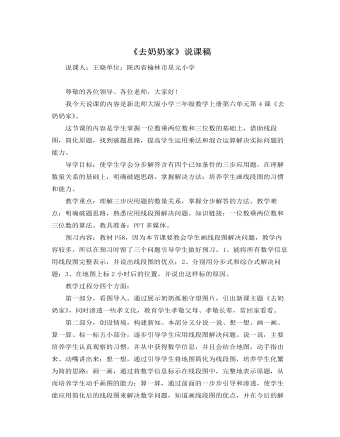
北师大版小学数学三年级上册《去奶奶家》说课稿
我今天说课的内容是新北师大版小学三年级数学上册第六单元第4课《去奶奶家》。这节课的内容是学生掌握一位数乘两位数和三位数的基础上,借助线段图,简化原题,找到破题思路,提高学生运用乘法和混合运算解决实际问题的能力。导学目标:使学生学会分步解答含有四个已知条件的三步应用题,在理解数量关系的基础上,明确破题思路,掌握解决方法;培养学生画线段图的习惯和能力。教学重点:理解三步应用题的数量关系,掌握分步解答的方法。教学难点:明确破题思路,熟悉应用线段图解决问题。知识链接:一位数乘两位数和三位数的算法。教具准备:PPT多媒体。预习内容:教材P58,因为本节课要教会学生画线段图解决问题,教学内容较多,所以在预习时留了三个问题引导学生做好预习。1、能将所有数学信息用线段图完整表示,并说出线段图的优点;2、分别用分步式和综合式解决问题;3、在地图上标2小时后的位置,并说出这样标的原因。
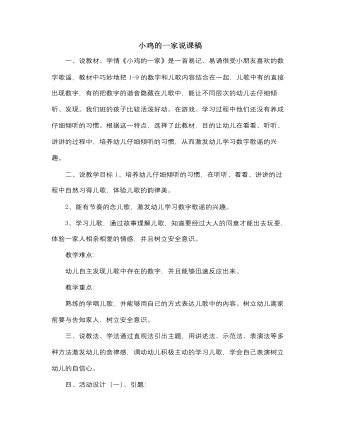
人音版小学音乐二年级上册小鸡的一家说课稿
5、请小朋友回去后把学会的儿歌念给爸爸妈妈听,请他们猜猜,儿歌里藏着多少数字?小鸡一家一共有几只小鸡?活动总结及反思1、儿歌的内容和形式比较吸引幼儿。整个活动的设计由易到难,层层递进,提问体现层次性。幼儿通过看、听、表演等形式,表现出对学习数字歌谣的浓厚兴趣。儿歌的主题贴近幼儿的生活,有利于幼儿理解、分享交流、想象扩散。在目标、内容上能与计算、德育、生活相结合,体现整合观。2、儿歌中小鸡一家还隐藏着数字"10",可以让幼儿回家和家长一起把数字"10"编入儿歌。这样使儿歌更有完整性,也能让家长参与,体现家园互动。3、幼儿在念儿歌时,有些生疏,教师可以提醒幼儿想着数字顺序、记着数字念儿歌。让孩子学会念数字歌谣的方法4、活动的过程中幼儿可能容易走神,如何抓住幼儿的注意力,让整堂课可以顺利的完成成为考验教师的难点。
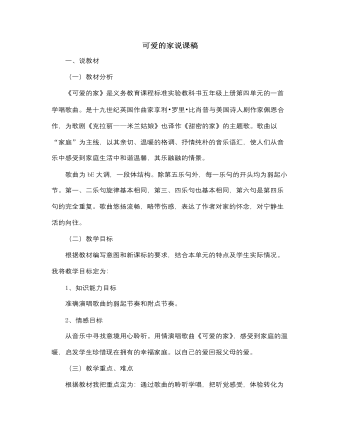
人音版小学音乐五年级上册可爱的家说课稿
4、带唱利用电子琴伴奏,教师带唱的方式,引导学生唱好弱起节奏和附点节奏。第三个环节延伸[设计理念:新课改提倡学科综合。依据这一理念,我在这一环节中让学生动手画一画,体现了音乐与美术的联系,让学生从画中体会家的温馨。再用歌声表达自己对家的感情。1、画一画让学生动手画一画自己的家。提示学生家是怎么样的?有哪些人?2、说一说先让学生说一说自己画的“家”(可以是想象的家),再说说自己“可爱的家”(真实的家),启发学生感受到父母对孩子的爱是无私的爱,启发学生珍惜现在拥有的幸福家庭,以自己的爱去回报父母的爱。3、唱一唱让学生把听觉感受、体验转化为自我表现。我让个别学生来演唱,强调学生用“自然”、“自主”、“自信”有表情的来演唱。
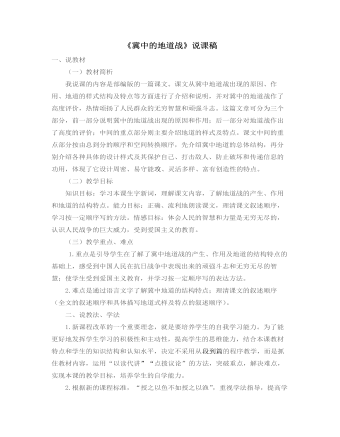
部编人教版五年级上册《 冀中的地道战》说课稿
一、说教材 (一)教材简析我说课的内容是部编版的一篇课文。课文从冀中地道战出现的原因、作用、地道的样式结构及特点等方面进行了介绍和说明,并对冀中的地道战作了高度评价,热情颂扬了人民群众的无穷智慧和顽强斗志。这篇文章可分为三个部分,前一部分说明冀中的地道战出现的原因和作用;后一部分对地道战作出了高度的评价;中间的重点部分则主要介绍地道的样式及特点。课文中间的重点部分按由总到分的顺序和空间转换顺序,先介绍冀中地道的总体结构,再分别介绍各种具体的设计样式及其保护自己、打击敌人、防止破坏和传递信息的功用,体现了它设计周密、易守能攻、灵活多样、富有创造性的特点。(二)教学目标知识目标:学习本课生字新词,理解课文内容,了解地道战的产生、作用和地道的结构特点。能力目标:正确、流利地朗读课文,理清课文叙述顺序,学习按一定顺序写的方法。情感目标:体会人民的智慧和力量是无穷无尽的,认识人民战争的巨大威力,受到爱国主义的教育。
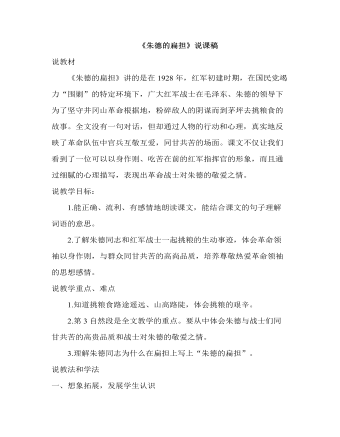
部编人教版二年级上册《朱德的扁担》说课稿
《语文课程标准》指出:“语文课程丰富的人文内涵对人们的精神领域的影响是深广的,学生对语文材料的反映往往也是多元的。”启发学生借助教材展开想象,并通过换位思考,体验人物内心,从吸收至倾吐,发展学生的语言,发展学生的思维,从而切实提高学生的认识,指导他们的生活。首先在教学过程中引导学生主动思维,激发学生的情感,从自己的身边去发现,去对比,加强对当时革命状况的了解,从而引发对革命事业崇敬之情。其次在教学的过程中,教师创设这样一个情境,把学生置身于故事所在的背景中,使得学生把自己当作是故事中的一员来参与,参与其中的艰辛,参与其中的心理过程,这样不但有助于教学的开展,而且也可以让学生能够更加的感同身受,激发学生对革命领导人的尊敬与热爱。





















